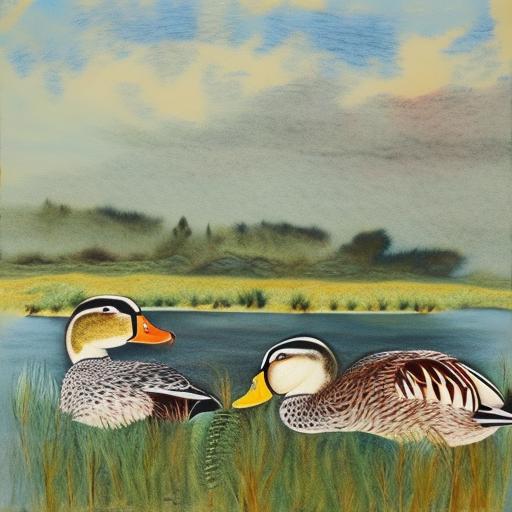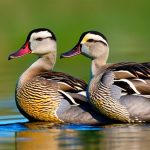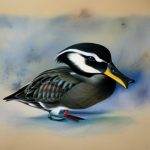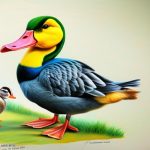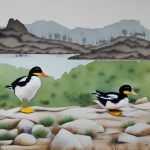Wild ducks are a diverse group of waterfowl that can be found in a variety of habitats around the world. These birds are known for their beautiful plumage, distinctive calls, and unique behaviors. There are many different species of wild ducks, each with its own characteristics and traits. In this article, we will explore some of the most well-known wild duck breeds, including the Mallard Duck, Wood Duck, Northern Pintail, Gadwall, American Wigeon, and Canvasback. Each of these breeds has its own unique features and is a fascinating example of the diversity of the natural world.
Key Takeaways
- There are several wild duck breeds, each with unique characteristics and habitats.
- Mallard ducks are the most common and widely recognized wild duck breed, known for their vibrant green heads and distinctive quacking.
- Wood ducks are known for their stunning and colorful plumage, making them one of the most visually appealing wild duck breeds.
- Northern pintails are easily recognizable by their long, elegant necks and pointed tails, and are often found in shallow wetlands and marshes.
- Gadwalls are a relatively common wild duck breed, known for their mottled gray and brown plumage and distinctive white wing patches.
- American wigeons are known for their unique and varied diet, which includes both aquatic plants and insects, and are often found in freshwater marshes and ponds.
- Canvasbacks are known for their striking red heads and long, sloping profile, and are often found in large, open bodies of water such as lakes and bays.
Mallard Duck
The Mallard Duck is perhaps the most well-known and recognizable wild duck breed. These ducks can be found throughout North America, Europe, and Asia, and are known for their distinctive green heads, white neck rings, and chestnut-brown chests. Mallards are highly adaptable and can be found in a wide range of habitats, from urban parks to remote wetlands. They are also a popular game bird and are often hunted for sport. Mallards are known for their loud quacking calls and are a common sight in ponds, lakes, and rivers. These ducks are also known for their strong migratory instincts and can travel long distances during their annual migrations.
The Mallard Duck is a dabbling duck, meaning that it feeds by tipping its head down into the water to reach aquatic plants and invertebrates. They are also known to feed on grains and seeds found in agricultural fields. Mallards are highly social birds and can often be found in large flocks, especially during the winter months. They are also known for their elaborate courtship displays, which involve the male performing a series of intricate movements and vocalizations to attract a mate. Mallards are a beloved symbol of the natural world and are a common sight in many urban and rural environments.
Wood Duck
The Wood Duck is a stunningly beautiful wild duck breed that can be found in North America. These ducks are known for their vibrant plumage, which includes iridescent green and purple head feathers, a striking white throat, and intricate patterns on their flanks. Wood Ducks are often found in wooded wetlands, where they nest in tree cavities or nest boxes. They are highly adaptable and can also be found in swamps, marshes, and beaver ponds. Wood Ducks are known for their distinctive whistling calls and are a popular sight for birdwatchers and nature enthusiasts.
Wood Ducks are unique among wild duck breeds in that they have sharp claws on their feet, which allow them to perch and nest in trees. They are also one of the few duck species that have strong homing instincts and will often return to the same nesting site year after year. Wood Ducks are omnivorous and feed on a variety of foods, including acorns, seeds, fruits, insects, and aquatic plants. They are also known for their elaborate courtship displays, which involve the male performing aerial acrobatics and vocalizations to attract a mate. Wood Ducks are a beloved symbol of the natural world and are a common sight in many wetland habitats.
Northern Pintail
The Northern Pintail is a graceful and elegant wild duck breed that can be found throughout North America, Europe, and Asia. These ducks are known for their long, slender necks, pointed tails, and distinctive chocolate-brown heads with white stripes. Northern Pintails are highly migratory and can travel long distances during their annual migrations. They are often found in shallow wetlands, marshes, and coastal estuaries, where they feed on aquatic plants, seeds, and invertebrates. Northern Pintails are also popular game birds and are often hunted for sport.
Northern Pintails are dabbling ducks and feed by tipping their heads down into the water to reach food. They are highly social birds and can often be found in large flocks during the winter months. Northern Pintails are also known for their elaborate courtship displays, which involve the male performing intricate movements and vocalizations to attract a mate. These displays often include the male raising its tail and neck while calling loudly to potential mates. Northern Pintails are a beloved symbol of the natural world and are a common sight in many wetland habitats.
Gadwall
The Gadwall is a medium-sized wild duck breed that can be found throughout North America, Europe, and Asia. These ducks are known for their mottled gray plumage, which provides excellent camouflage in their marshland habitats. Gadwalls are often found in shallow wetlands, marshes, and coastal estuaries, where they feed on aquatic plants, seeds, and invertebrates. They are also popular game birds and are often hunted for sport. Gadwalls are known for their distinctive quacking calls and can often be found in large flocks during the winter months.
Gadwalls are dabbling ducks and feed by tipping their heads down into the water to reach food. They are highly adaptable and can also be found in agricultural fields and urban parks. Gadwalls are highly social birds and can often be found in large flocks during the winter months. They are also known for their elaborate courtship displays, which involve the male performing intricate movements and vocalizations to attract a mate. Gadwalls are a beloved symbol of the natural world and are a common sight in many wetland habitats.
American Wigeon

The American Wigeon is a medium-sized wild duck breed that can be found throughout North America. These ducks are known for their distinctive breeding plumage, which includes a creamy forehead patch, iridescent green eye patches, and a striking white belly. American Wigeons are often found in shallow wetlands, marshes, and coastal estuaries, where they feed on aquatic plants, seeds, and invertebrates. They are also popular game birds and are often hunted for sport. American Wigeons are known for their whistling calls and can often be found in large flocks during the winter months.
American Wigeons are dabbling ducks and feed by tipping their heads down into the water to reach food. They are highly adaptable and can also be found in agricultural fields and urban parks. American Wigeons are highly social birds and can often be found in large flocks during the winter months. They are also known for their elaborate courtship displays, which involve the male performing intricate movements and vocalizations to attract a mate. American Wigeons are a beloved symbol of the natural world and are a common sight in many wetland habitats.
Canvasback
The Canvasback is a large and striking wild duck breed that can be found throughout North America. These ducks are known for their distinctive red heads, long sloping profiles, and bright white backs. Canvasbacks are often found in shallow wetlands, marshes, and coastal estuaries, where they feed on aquatic plants, seeds, and invertebrates. They are also popular game birds and are often hunted for sport. Canvasbacks are known for their distinctive calls and can often be found in large flocks during the winter months.
Canvasbacks are diving ducks and feed by diving underwater to reach food. They have specialized bills that allow them to strain small seeds from the water’s surface. Canvasbacks are highly social birds and can often be found in large flocks during the winter months. They are also known for their elaborate courtship displays, which involve the male performing intricate movements and vocalizations to attract a mate. Canvasbacks are a beloved symbol of the natural world and are a common sight in many wetland habitats.
In conclusion, wild duck breeds are a diverse group of waterfowl that can be found in a variety of habitats around the world. Each breed has its own unique characteristics and traits that make them fascinating examples of the diversity of the natural world. Whether it’s the iconic Mallard Duck with its distinctive green head or the elegant Northern Pintail with its long neck and pointed tail, wild ducks capture the imagination of birdwatchers and nature enthusiasts around the world. Their beauty, adaptability, and unique behaviors make them an important part of our natural heritage.
If you’re interested in learning more about wild duck breeds, you might also want to check out Poultry Wizard’s article on different types of chicken coops. They offer a variety of coop designs, including the A-Frame Chicken Coop, the Chicken Coop Portage, and the Farmhouse Chicken Coop. These coops are not only functional but also visually appealing, providing a comfortable and safe environment for your poultry.
FAQs
What are some common wild duck breeds?
Some common wild duck breeds include the Mallard, Wood Duck, Northern Pintail, Gadwall, and American Wigeon.
What do wild ducks look like?
Wild ducks come in a variety of colors and patterns, but they generally have a streamlined body, webbed feet, and a distinctive bill. Male ducks, called drakes, often have more vibrant and colorful plumage compared to female ducks.
Where can wild ducks be found?
Wild ducks can be found in a variety of habitats including freshwater lakes, rivers, marshes, and coastal areas. They are also commonly found in urban parks and ponds.
What do wild ducks eat?
Wild ducks are omnivorous and their diet consists of a variety of foods including aquatic plants, insects, small fish, and crustaceans.
Are wild ducks protected by law?
In many countries, wild ducks are protected by law to prevent overhunting and ensure their conservation. It is important to check local regulations before hunting or interacting with wild ducks.
How can I attract wild ducks to my property?
To attract wild ducks to your property, you can create a suitable habitat by providing a water source, natural vegetation, and nesting sites. Additionally, offering duck-friendly foods such as cracked corn, oats, and birdseed can also attract wild ducks.
Meet Walter, the feathered-friend fanatic of Florida! Nestled in the sunshine state, Walter struts through life with his feathered companions, clucking his way to happiness. With a coop that’s fancier than a five-star hotel, he’s the Don Juan of the chicken world. When he’s not teaching his hens to do the cha-cha, you’ll find him in a heated debate with his prized rooster, Sir Clucks-a-Lot. Walter’s poultry passion is no yolk; he’s the sunny-side-up guy you never knew you needed in your flock of friends!

